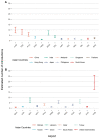Yellow fever in Asia-a risk analysis
- PMID: 33506250
- PMCID: PMC8045179
- DOI: 10.1093/jtm/taab015
Yellow fever in Asia-a risk analysis
Abstract
Background: There is concern about the risk of yellow fever (YF) establishment in Asia, owing to rising numbers of urban outbreaks in endemic countries and globalisation. Following an outbreak in Angola in 2016, YF cases were introduced into China. Prior to this, YF had never been recorded in Asia, despite climatic suitability and the presence of mosquitoes. An outbreak in Asia could result in widespread fatalities and huge economic impact. Therefore, quantifying the potential risk of YF outbreaks in Asia is a public health priority.
Methods: Using international flight data and YF incidence estimates from 2016, we quantified the risk of YF introduction via air travel into Asia. In locations with evidence of a competent mosquito population, the potential for autochthonous YF transmission was estimated using a temperature-dependent model of the reproduction number and a branching process model assuming a negative binomial distribution.
Results: In total, 25 cities across Asia were estimated to be at risk of receiving at least one YF viraemic traveller during 2016. At their average temperatures, we estimated the probability of autochthonous transmission to be <50% in all cities, which was primarily due to the limited number of estimated introductions that year.
Conclusion: Despite the rise in air travel, we found low support for travel patterns between YF endemic countries and Asia resulting in autochthonous transmission during 2016. This supports the historic absence of YF in Asia and suggests it could be due to a limited number of introductions in previous years. Future increases in travel volumes or YF incidence can increase the number of introductions and the risk of autochthonous transmission. Given the high proportion of asymptomatic or mild infections and the challenges of YF surveillance, our model can be used to estimate the introduction and outbreak risk and can provide useful information to surveillance systems.
Keywords: Aedes; Arbovirus; Flavivirus; Modelling; Outbreak; Surveillance; Travel.
© International Society of Travel Medicine 2021. Published by Oxford University Press.
Figures



References
-
- Monath TP. Yellow fever: an update. Lancet Infect Dis 2001; 1:11–20. - PubMed
-
- Monath TP. Facing up to re-emergence of urban yellow fever. Lancet 1999; 353:1541. - PubMed
-
- Ho YL, Joelsons D, Leite GFC et al. Severe yellow fever in Brazil: clinical characteristics and management. J Travel Med 2019; 26:taz040. - PubMed
-
- Monath TP, Woodall JP, Gubler DJ et al. Yellow fever vaccine supply: a possible solution. Lancet 2016; 387:1599–600. - PubMed
MeSH terms
Grants and funding
LinkOut - more resources
Full Text Sources
Other Literature Sources
Medical

